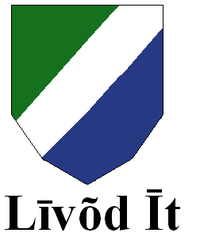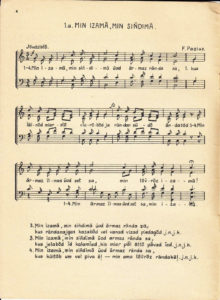
The main symbol used by the Livonians, is the Livonian flag, adopted by the Livonian Union (Līvõd Īt) at its first meeting on March 2, 1923. Raised for the first time at the Livonian festival in Irē on November 18, 1923, the green, white, blue banner was designed to reflect the life and world of this nation of fishermen. The green is symbolic of the coastal forests, the white of the white sands of the coast, as well as, the bright thoughts and feelings of the fishermen thinking of their homes and families, the blue of the deep blue waters of the sea. The proportions of the flag are 2:1:2, the same as those of the Latvian flag. (Šuvcāne 1995:134) During the years of the Soviet occupation, use of the flag was forbidden, but with the reestablishment of Latvian independence in 1990, it once again became the standard symbol used by the Livonian people and their cultural organizations.


The Livonian Union also uses an emblem charged with the colors of the flag. Shaped like a shield, the colors are displayed diagonally across the emblem. (Karma 1994:79)
The Livonian national anthem “Min izāmō, min sindimō” (My Fatherland, Land of my Birth) has the same melody as the Finnish and Estonian national anthems. The image below shows the text of the Livonian anthem as it appeared in Kōrli Stalte’s (Kārlis Stalte) 1929 collection of Livonian songs. Click here for the text of the anthem written in the present-day orthography.
______________________________
Karma, Tõnu. (Tenu Karma). 1995. “Lībieši.” (The Livonians.) Kurzeme un Kurzemnieki. Ed. A. Vītols. Rīga: Latvijas Enciklopēdija.
Stalte, Kōrli (Kārlis Stalte). 1929. Līvõkīel lōlõd. (Livonian Songs.) Helsinki: Wikstedt’in kivdrukkõs.
Šuvcāne, Valda. 1994. “Lībiešu kultūras dzīve 20. gadsimta 20. un 30. gados.” (Livonian cultural life in the 1920s and 1930s.) Lībieši. Rīga: Zinātne.